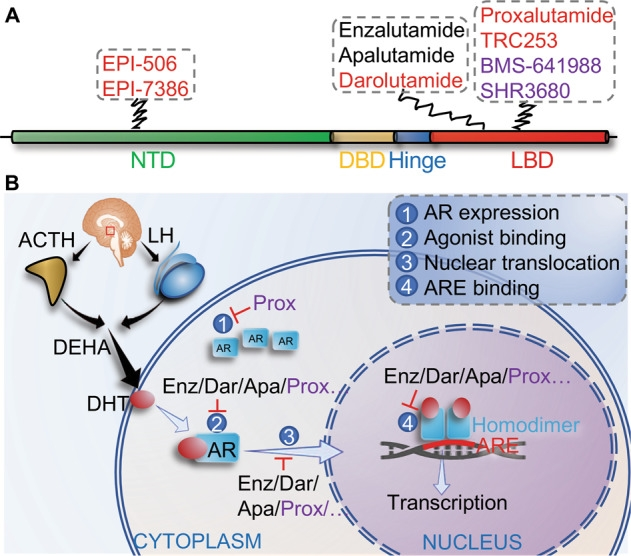A very good article for fellow warriors on 2nd gen AR antagonists and resistance with options and trials. Plus cutting edge technologies in the works. Also covers some new generation AR antagonist Proxalutamide (GT-0918) is a full AR antagonist which has 3-fold higher binding affinity in comparison with enzalutamide
Second generation androgen receptor a... - Advanced Prostate...
Second generation androgen receptor antagonists and challenges in prostate cancer treatment

Thanks for posting. Great read, although slightly sobering if like me your currently taking Enzalutamide.
I read your Bio, Tennis and running! That will knock most of the side effects out of the park. Well done keep it up.
Thx for posting. Interesting that a dose reduction could lead to better outcome with less SE.
I didn't see any mention of dose reduction and which drug are you talking about with this reduction?
I searched the article for " dose" and all that came up is one reference 150
Kolinsky, M. P. et al. A phase I dose-escalation study of enzalutamide in combination with the AKT inhibitor AZD5363 (capivasertib) in patients with metastatic castration-resistant prostate cancer. Ann. Oncol. 31, 619–625 (2020).
I referred to:
One possible contributor to both the side effects and the induction of drug resistance is the high dose of AR antagonists currently administered to patients. Indeed, our study has found that 25 μM of enzalutamide that imitates the real dose of enzalutamide in patients induced higher expression of cancer-related genes such as GR and SLC7A11, in comparison with 10 μM of enzalutamide [104]. Therefore, multipoint targeting of the AR signaling pathway may accomplish the same or even greater antitumor effect while reducing side-effects, which may slow down the induction of resistance and cancer progression. A meta-analysis of two phase 3 trials has shown that abiraterone and prednisolone, which target androgen synthesis, can combine with enzalutamide to significantly improve metastasis-free survival in high-risk non-metastatic prostate cancer [150].
Im going to get a tatto of that pic......🤪
Another statement for synergy with the lutamides is inducers of ferroptosis
"Other promising combined therapies involving immunotherapy, CDK inhibitors and radiotherapy are summarized in Table Table3.3. Notably, we and other groups have demonstrated that enzalutamide and darolutamide can induce the expression of ferroptosis-related genes in both ADPC and CRPC [104, 152], which have proven to be correlated with prostate cancer recurrence [153, 154]. Targeting ferroptosis might be a novel therapeutic strategy for advanced prostate cancer, as ferroptosis inducers significantly decrease prostate cancer cell growth and migration in vitro and delay tumor growth of treatment-resistant prostate cancer in vivo, with no measurable side effects [155, 156]. Further clinical trials are needed to test the potential of this therapeutic strategy."
Following the last reference 156
"156. Zhou X, Zou L, Chen W, Yang T, Luo J, Wu K, et al. Flubendazole, FDA-approved anthelmintic, elicits valid antitumor effects by targeting P53 and promoting ferroptosis in castration-resistant prostate cancer. Pharm Res. 2021;164:105305. doi: 10.1016/j.phrs.2020.105305. [PubMed] [CrossRef] [Google Scholar] [Ref list]"
This got me to thinking abour fenbendazol, mebendazol and and for me being an herbalist is Black walnuts Juglans nigra which has juglones which are natural anthilmintics.
I harvest the spring May buds and or the fall green husks of the nut you can smell the perfume scent. So here is an article on Black Walnut on ferroptosis:
pubmed.ncbi.nlm.nih.gov/341...
"Juglone, a novel activator of ferroptosis, induces cell death in endometrial carcinoma Ishikawa cells"
pubmed.ncbi.nlm.nih.gov/331...
Flubendazole, FDA-approved anthelmintic, elicits valid antitumor effects by targeting P53 and promoting ferroptosis in castration-resistant prostate cancer
nature.com/articles/s41391-...
The role of ferroptosis in prostate cancer: a novel therapeutic strategy
"Ferroptosis is considered to be associated with a variety of human diseases, such as neurodegeneration, ischemia-reperfusion injury, and various cancers, including prostate cancer [13,14,15,16,17]. Tumor cells are more dependent on iron than normal cells for their high proliferation rate. This phenomenon is called iron addiction [18]. The discovery of ferroptosis makes people have a new understanding of the occurrence and development of tumor diseases. There is increasing evidence that ferroptosis leads to tumor growth inhibition. Using inducers to induce ferroptosis or regulate ferroptosis-related genes may become an anti-cancer strategy. Therefore, it is great significance to understand the mechanism of ferroptosis and its research progress in prostate cancer."
What has me very concerned Darolutamide in my case is the inevitable lethal neuroendocrine prostate cancer (NEPC).
The utility of these agents has expanded with the emergence of second-generation AR antagonists, which began with the approval of enzalutamide in 2012 by the United States Food and Drug Administration (FDA). Together with apalutamide and darolutamide, which were approved in 2018 and 2019, respectively, these agents have improved the survival of patients with prostate cancer, with applications for both androgen-dependent and castration-resistant disease. While patients receiving these drugs receive a benefit in the form of prolonged survival, they are not cured and ultimately progress to lethal neuroendocrine prostate cancer (NEPC).
Another reason to start BAT sooner rather than later